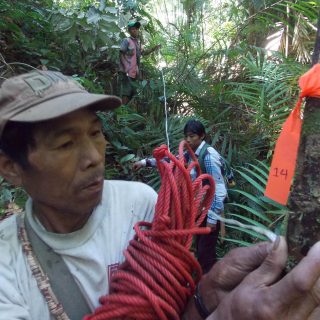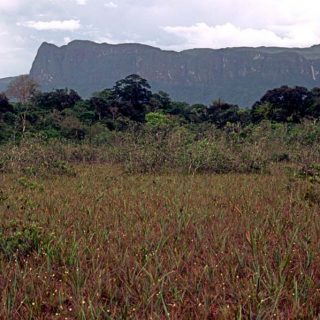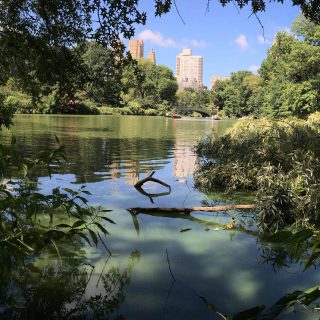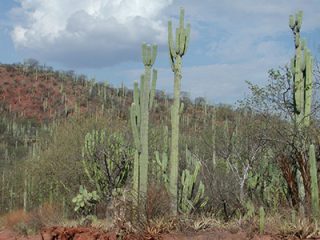
Britton Gallery Talks 2017
Intimate conversations with Garden scientists about a typical day of work include behind-the-scenes tours of Science facilities. Exclusive to Members.
Space for these programs are limited; reservations are required.
For reservations, please e-mail membership@nybg.org or call 718.817.8703.

Villagers from NamSabi in Sagaing Region, Myanmar running inventory transects within their Village Management Area.
Managing the Wild: Thirty Years of Community Forestry Research at The New York Botanical Garden
Friday, May 5, 2017
2 p.m.–3 p.m.
A Conversation with Garden Scientist Charles M. Peters, Ph.D.
The conservation of tropical forests usually involves the creation of protected areas. In some cases, however, tropical forests can be conserved by working together with local communities to develop management plans for using the forest sustainably. Garden scientist Dr. Charles M. Peters discusses the community forestry efforts the Botanical Garden has been involved in for over 30 years — including in Central and South America, Southeast Asia, and Tropical Africa — and explains the conservation benefits accruing from these efforts. Following the talk is a demonstration of inventory and growth measurement techniques used to collect baseline data for community forestry.

Yellow eyed grasses growing in Cerro Sipapo, as viewed from Sabana de Cabeza (Amazonas state, Venezuela).
Diversity and Evolution in Ecologically Fragile Habitats: The Yellow Eyed Grasses
Friday, June 9, 2017
11 a.m.–12 p.m.
A Conversation with Garden Scientist Lisa M. Campbell, Ph.D.
The Yellow eyed grasses (plant family Xyridaceae, order Poales) are related to the world’s major grain crops (plant family Poaceae, order Poales), and study of Yellow eyed grasses may provide insights for improving grain crops and enhancing food security. Garden scientist Dr. Lisa M. Campbell discusses her work to understand the evolution and diversity of the 430 herbaceous species of Yellow eyed grass that occur in ecologically fragile habitats in tropical to temperate savannas, in wet lands, and on table-top mountains. Following the Talk is a tour of the Pfizer Plant Research Laboratory to see collections of Xyridaceae and some of the techniques used to determine their evolutionary relationships.

Central Park Lake with Bow Bridge in distance. American Water Horehound (below left), discovered in July 2016 for the first time in Central Park.
The New York City EcoFlora: Citizens Contributing Their Own Scientific Observations
Friday, August 25, 2017
11 a.m.–12 p.m.
A Conversation with Garden Scientists Brian M. Boom, Ph.D. and Daniel Atha
Dr. Brian M. Boom and Daniel Atha discuss the New York City EcoFlora, the Botanical Garden’s initiative combining what is already known about the 2,200 species of native and naturalized plants recorded from New York City (NYC) with new, original observations made by volunteer citizen scientists. Citizen scientists are working across all five boroughs of NYC, during all seasons of the year, in what is, in fact, an ongoing urban bioblitz. They are also uploading their information directly into the New York City EcoFlora database. Learn how you can get involved! Following the Talk is a walk into the Thain Family Forest to see first-hand the kinds of plant observations citizen scientists are making.

Cacti provide an excellent example of evolutionary problem solving.
Evolution and the Tree of Life: Problem-solving Through Time
Friday, October 13, 2017
2 p.m.–3 p.m.
A Conversation with Garden Scientists Dennis Wm. Stevenson, Ph.D., Barbara Ambrose, Ph.D., and Lawrence M. Kelly, Ph.D.
As Charles Darwin famously recognized, the evolution of living things has been occurring for billions of years and is responsible for the marvelous diversity of life on Earth. Drs. Stevenson, Ambrose, and Kelly discuss evolution as a problem-solving process resulting in change over time and explain the Botanical Garden’s modern research on understanding plant portions of the evolutionary Tree of Life (family tree of living things). Following the talk is a tour of the Enid A. Haupt Conservatory to look at representative plants on the evolutionary tree and note some particular problem-solving that has occurred in Earth’s different biomes.